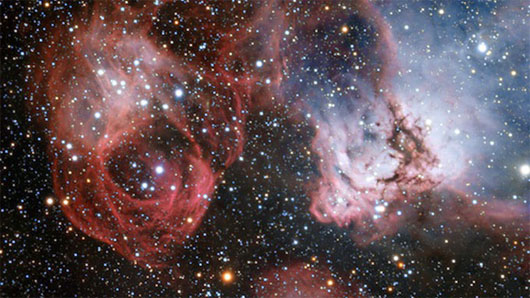Photograph the process of birth and death of stars
The Southern European Astronomical Observatory has just captured a photograph of the formation and death of stars at the Large Magellanic Clound (the large Magellanic Nebula).
According to Science.com, the LMC galaxy is located 163,000 light-years from Earth. This is one of the Milky Way's closest neighbors. In the southern hemisphere, we can observe this galaxy with the naked eye.

The photo captures the area of the Dragon Head Nebula, where the stars were born and died - (Photo: Earthsky)
A special photo was taken by a South Europe Observatory VLT telescope in Chile capturing an area called NGC2035 in the LMC galaxy. Due to its strange appearance, this is an area nicknamed Dragon's Head Nebula .
In the picture, the right bright area is the new stars that form and shine, creating a tremendous amount of heat. These stars often burn very bright but have a short lifetime if compared to our sun.
In contrast, the cloud of gas and dust on the left side of the picture is the remnant of the dead stars. Due to their enormous size, they quickly burned off the fuel, became unstable and exploded (supernova) at the end of life. Their death left these marks on.
'This photo is like a work of art - BBC quoted Southern Europe Observatory Olivier Hainaut - When you look at it, you realize that you are witnessing small parts of the universe right next to you. me Stars that are born and die are evidence that the universe is moving and evolving '.
- How are stars created?
- Discover the journey of
- Find places to produce stars in the universe
- How brown stars form
- Early birth rate increases
- Discovered that twin stars are being incubated in a physical disk
- Coming up, people will master the death
- The process of decomposition of the human body after death
- Process of injecting poison for death row inmates
- The mysterious death of some stars
- Date of death depends on the date of birth?
- Photo of the largest Milky Way galaxy ever
 Van Allen's belt and evidence that the Apollo 11 mission to the Moon was myth
Van Allen's belt and evidence that the Apollo 11 mission to the Moon was myth The levels of civilization in the universe (Kardashev scale)
The levels of civilization in the universe (Kardashev scale) Today Mars, the sun and the Earth are aligned
Today Mars, the sun and the Earth are aligned The Amazon owner announced a secret plan to build a space base for thousands of people
The Amazon owner announced a secret plan to build a space base for thousands of people